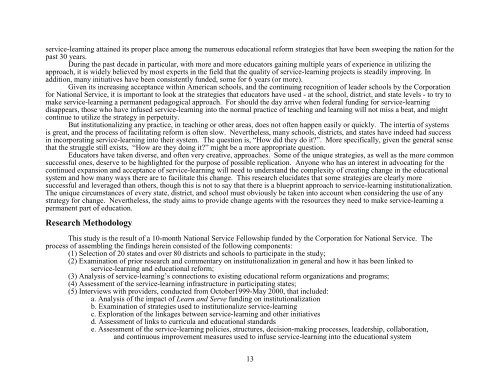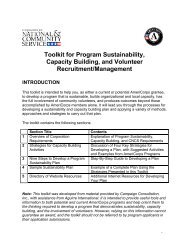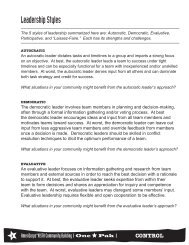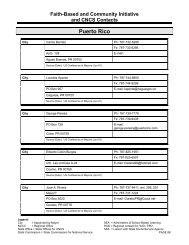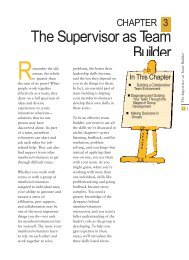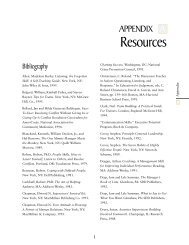MAKE IT LAST FOREVER: THE ... - National Service Resource Center
MAKE IT LAST FOREVER: THE ... - National Service Resource Center
MAKE IT LAST FOREVER: THE ... - National Service Resource Center
You also want an ePaper? Increase the reach of your titles
YUMPU automatically turns print PDFs into web optimized ePapers that Google loves.
service-learning attained its proper place among the numerous educational reform strategies that have been sweeping the nation for the<br />
past 30 years.<br />
During the past decade in particular, with more and more educators gaining multiple years of experience in utilizing the<br />
approach, it is widely believed by most experts in the field that the quality of service-learning projects is steadily improving. In<br />
addition, many initiatives have been consistently funded, some for 6 years (or more).<br />
Given its increasing acceptance within American schools, and the continuing recognition of leader schools by the Corporation<br />
for <strong>National</strong> <strong>Service</strong>, it is important to look at the strategies that educators have used - at the school, district, and state levels - to try to<br />
make service-learning a permanent pedagogical approach. For should the day arrive when federal funding for service-learning<br />
disappears, those who have infused service-learning into the normal practice of teaching and learning will not miss a beat, and might<br />
continue to utilize the strategy in perpetuity.<br />
But institutionalizing any practice, in teaching or other areas, does not often happen easily or quickly. The intertia of systems<br />
is great, and the process of facilitating reform is often slow. Nevertheless, many schools, districts, and states have indeed had success<br />
in incorporating service-learning into their system. The question is, “How did they do it?”. More specifically, given the general sense<br />
that the struggle still exists, “How are they doing it?” might be a more appropriate question.<br />
Educators have taken diverse, and often very creative, approaches. Some of the unique strategies, as well as the more common<br />
successful ones, deserve to be highlighted for the purpose of possible replication. Anyone who has an interest in advocating for the<br />
continued expansion and acceptance of service-learning will need to understand the complexity of creating change in the educational<br />
system and how many ways there are to facilitate this change. This research elucidates that some strategies are clearly more<br />
successful and leveraged than others, though this is not to say that there is a blueprint approach to service-learning institutionalization.<br />
The unique circumstances of every state, district, and school must obviously be taken into account when considering the use of any<br />
strategy for change. Nevertheless, the study aims to provide change agents with the resources they need to make service-learning a<br />
permanent part of education.<br />
Research Methodology<br />
This study is the result of a 10-month <strong>National</strong> <strong>Service</strong> Fellowship funded by the Corporation for <strong>National</strong> <strong>Service</strong>. The<br />
process of assembling the findings herein consisted of the following components:<br />
(1) Selection of 20 states and over 80 districts and schools to participate in the study;<br />
(2) Examination of prior research and commentary on institutionalization in general and how it has been linked to<br />
service-learning and educational reform;<br />
(3) Analysis of service-learning’s connections to existing educational reform organizations and programs;<br />
(4) Assessment of the service-learning infrastructure in participating states;<br />
(5) Interviews with providers, conducted from October1999-May 2000, that included:<br />
a. Analysis of the impact of Learn and Serve funding on institutionalization<br />
b. Examination of strategies used to institutionalize service-learning<br />
c. Exploration of the linkages between service-learning and other initiatives<br />
d. Assessment of links to curricula and educational standards<br />
e. Assessment of the service-learning policies, structures, decision-making processes, leadership, collaboration,<br />
and continuous improvement measures used to infuse service-learning into the educational system<br />
13


